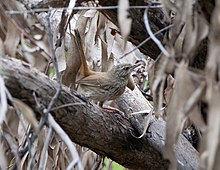
Updated 9 Feb 2017, 9:38pm
Planned burn-offs, which play an important role in protecting lives and properties from summer bushfires, are becoming increasingly critical to the survival of a rare bird species in South Australia.
The chestnut rumped heathwren has a subspecies which is found only in the Mt Lofty Ranges around Adelaide, and is considered endangered.
Fire ecologist Kirstin Abley said her team had only recently discovered fire was a vital part of maintaining the tiny bird's habitat.
"Initially we didn't realise they had a preference for recently-burnt habitat, and we thought they preferred longer unburnt habitat," she said.
"We're very good at putting out bushfires, so a lot of the habitat the heathwren has been occupying is long unburnt."
Ms Abley said her team at Natural Resources Adelaide and Mt Lofty Ranges were now using prescribed burns to ensure sections of the landscape developed new, thick undergrowth the birds adored.
"We're burning small patches of that habitat and hopefully generating some that is optimal for them, so their numbers can increase because the food and shelter is better," she said.
But it's a tricky balancing act for the ecologists, who need to protect both lives and properties, as well as other species with different preferences.
Lives and homes a priority over threatened species
Ms Abley said while the ultimate responsibility of fire ecologists was safeguarding lives and property, it was nice when the work dovetailed with helping wildlife.
Continued
Ms Abley said while the ultimate responsibility of fire ecologists was safeguarding lives and property, it was nice when the work dovetailed with helping wildlife.
Continued
No comments:
Post a Comment